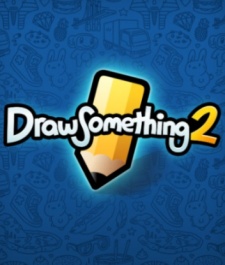Before its buyout, Draw Something enjoyed a remarkable rise to prominence, generating 30 million downloads within five weeks of its release and reportedly grossing $250,000 a day from some 15 million daily active users.
But soon after the deal was done, Draw Something's popularity began to wane.
Zynga's attempts to boost revenue through brand partnerships weren't enough to prevent the company having to write off somewhere between $85 million and $95 million related to the acquisition.
Despite this apparent fall from grace, Zynga has seen fit to serve up a sequel - two sequels, in fact, with the publisher mirroring OMGPOP's strategy of releasing both a paid and free version of the game.
So, can Zynga reignite the passion for Pictionary on the go? To find out, we've been examining the App Store charts.
Doubling up
At launch, Draw Something 2 Free went straight into #3 in the US App Store's top free apps chart, rising to #1 a day later.
By Sunday 28 April, Zynga's latest had been overtaken by Robot Unicorn Attack 2, but the game remains in second place on the downloads chart at the time of writing.
Draw Something 2 Free hasn't reached the same dizzy heights on the grossing charts, though.
On Thursday 25 April, the title entered the top grossing games chart at #257, rising to #109 a day later. It peaked at #87 on Sunday 28 April, before dropping to #89 on Monday 29.
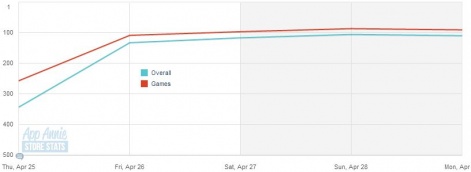
Analytics graph showing Draw Something 2 Free's performance of the US App Store's top grossing charts. Analytics data courtesy of App Annie.
The paid version of Draw Something 2, meanwhile, rose to #14 in the top paid games chart at launch and reached #3 two days later.
It remains at #3 on the paid games chart at the time of writing, behind Cut the Rope: Time Travel and Minecraft Pocket Edition.
But it's on the grossing charts that the paid version of Draw Something 2 really outperforms its free counterpart.
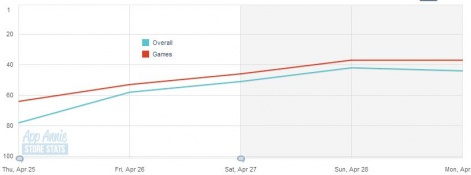
Analytics graph showing Draw Something 2's (paid version) performance on the US App Store's top grossing charts.
It reached #64 at launch, and steadily climbed through the ranks 53, 46, 37 over the next few days, before dropping slightly to #39 on Monday 29 April.
You pays your money...
It's interesting to see the paid version of Draw Something 2 is currently out performing its freemium sibling when it comes to earnings - something that suggests Zynga's decision to launch two versions of the game rather than sticking with its free-to-play only protocol was a wise move.
In fact, estimates provided to PocketGamer.biz by Distimo show that the paid version of Draw Something 2 generates 74 percent of the game's total revenue, while the free version accounts for just 26 percent.
It would seem that the $2.99 up-front cost which buys players an extra drawing tool, in-game currency bonuses, extra words and ad removal is working well for Zynga.
If you look purely at in-app purchase revenue, the two versions seem much more evenly matched.
48 percent of in-app purchase revenue comes from the free version of Draw Something 2, while 52 percent comes from the paid version.
But this data, which is based on the first four days since Draw Something 2's launch, may be misleading. The vast majority of Draw Something 2 players are using the free version it accounts for 97 percent of all downloads, in fact.
As such, an even spread of in-app purchase revenue actually means that the average user of the paid version of Draw Something 2 is spending many times more on IAPs than the average free user.
By our calculations, the average in-app purchase revenue per user for the $2.99 version of Draw Something 2 is roughly 35 times higher than the average IAP revenue per user for Draw Something 2 Free.
It's worth noting, though, that the unknown quantity that is advertising revenue may skew this comparison a little.
So-sophisticated
Draw Something 2 might not have cracked the upper echelons of the top grossing charts yet then, but there's still time for it to improve. Draw Something is, after all, a fundamentally social game, and such viral approaches can take time to spread.
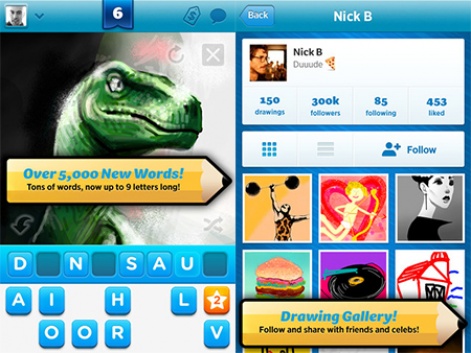
The original Draw Something had virality in spades, but lacked longevity. For this sequel, Zynga has worked hard to create something 'stickier'.
Draw Something 2's social features could boost both the game's eventual popularity and its lifespan, offering players the chance to save their drawings, earn achievements follow the galleries of other players, and 'like' their artistic creations.
Players can even follow celebrities so if you've ever wondered how accurately Will.i.am could render a starfish, Draw Something 2 offers you a chance to find out.
This sequel contains more complex monetisation mechanics than its predecessor too, making use of a dual-currency system as well as the aforementioned decision to release two versions of the app itself.
So whereas the original Draw Something offered coins that could be earned or purchased - before being redeemed for new drawing tools and the like - Draw Something 2 features coins and stars.
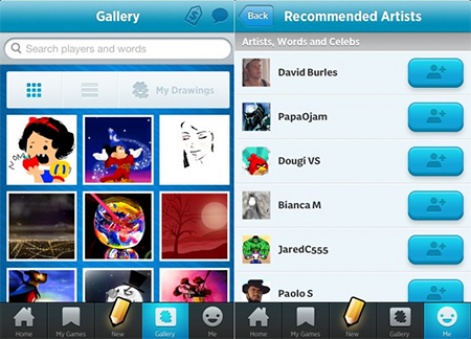
Coins, as before, are earned for completing each round. Stars, meanwhile, are rewarded for engaging with the game's social features, or for completing 5 'daily draws' in a row.
In this way, Zynga hopes to engage gamers for longer, and support a community over time in a way that the first Draw Something couldn't manage.
It's too soon to say whether this plan will work out of course, but it's clear that Zynga has high hopes that it can turn its expensive flash in the pan into a sustainable success.
A note on the methodology of Distimo estimatesDistimo AppIQ provides download and revenue estimations for any app worldwide, based on daily sampling of transactional app data (>3 billion downloads / quarter) and publicly available information.
When calculating downloads and revenues for individual apps, Distimo's unique methodology excludes that app's transactional data from the analysis to preserve the confidentiality of their users' data.

